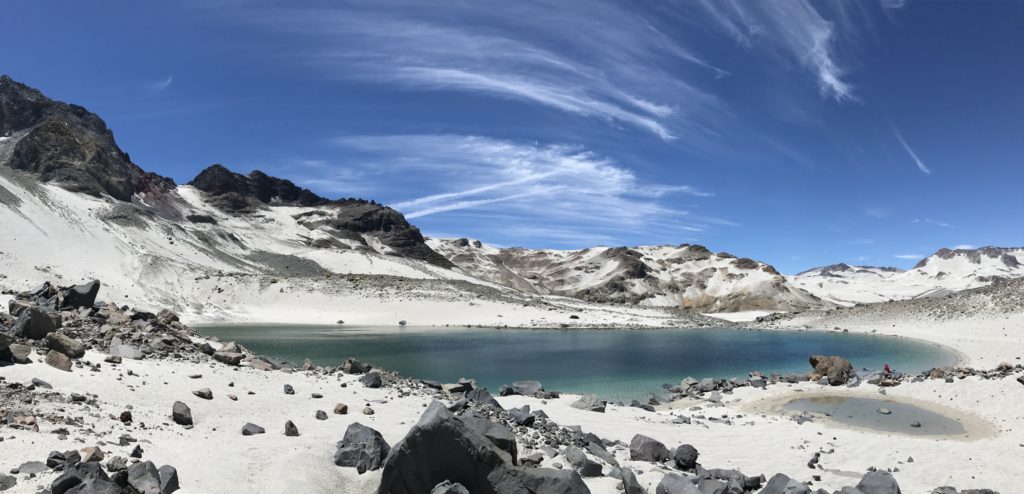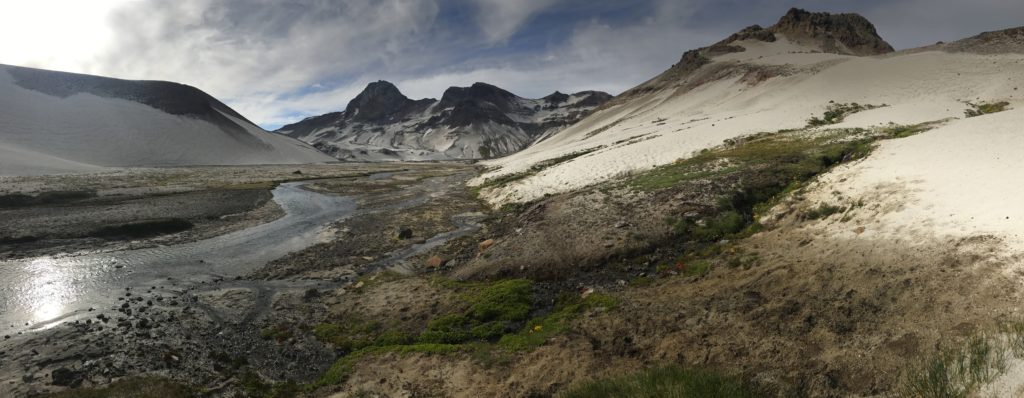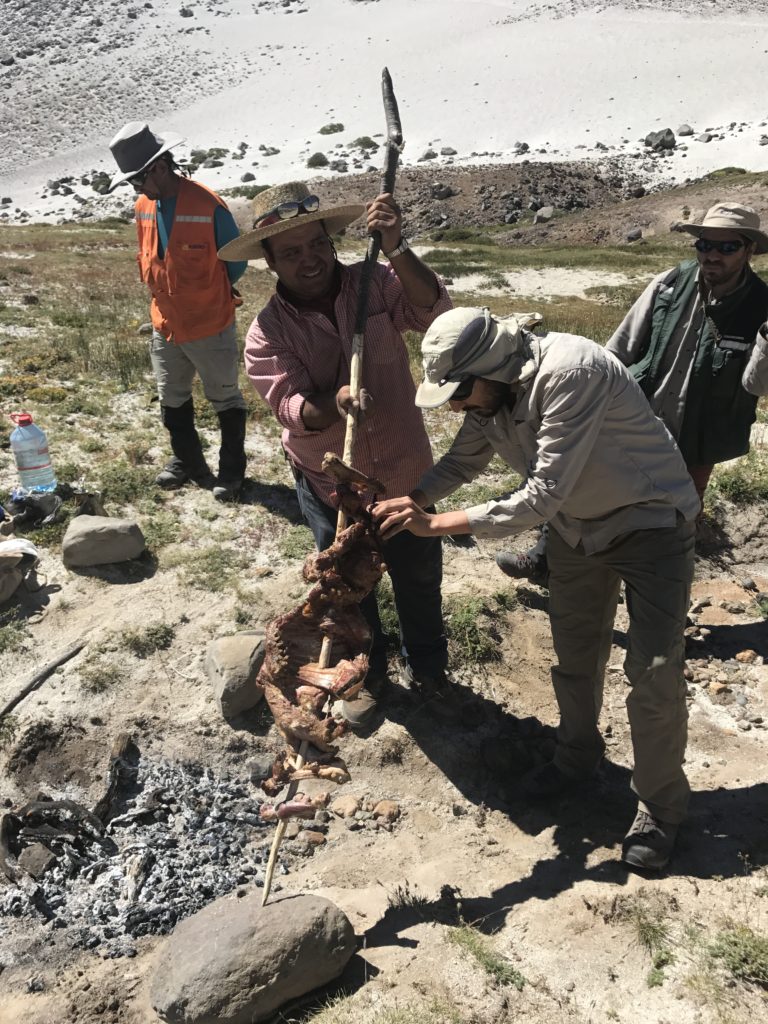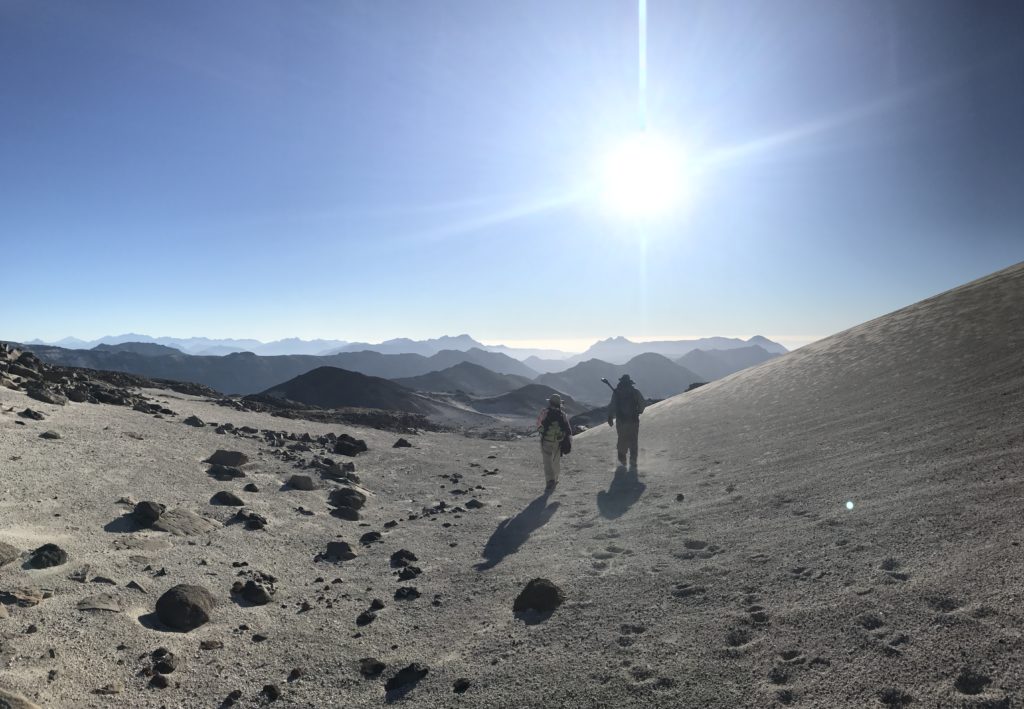Heather Winslow completed her BA in environmental science at Willamette University followed by a year of post-baccalaureate work at Oregon State University. She’s in her first year of graduate school at the University of Nevada, Reno pursuing her MS in geology. Heather is interested in using geochemistry and igneous petrology to understand the internal plumbing systems of magma chambers and eruptive processes within volcanic arcs.
There are many perks to the life of a geologist – one of which being the extraordinary places you get to call your “office”, and recently I had the opportunity to call the Central Andes mine.
In the fall of 2016, I started my master’s at the University of Nevada, Reno working with Dr. Philipp Ruprecht. This past January was my first field season, which consisted of three weeks under the southern sky and hiking up volcanoes with a backpack full of rocks. My field site is Volcán Manantial Pelado which is a poorly-studied basaltic andesite to andesite stratocone in the transition zone of the Southern Volcanic Andean Zone. Surrounded by regional, voluminous silicic magmatism, it is one of the few mafic centers in the area. The closest silicic cluster is located ~10 km to the SE of Manantial Pelado (Descabezado Grande-Cerro Azul (DG-CA) Volcanic Cluster). Manantial Pelado’s glacially dissected valleys provide access to its long eruptive history. My primary purpose is to understand the petrogenesis of this infrequent, mafic eruptive center in order to further understand the diversity of parental magmas in the area. Along with my main research question, I plan to address some broader questions such as: What was Manantial Pelado’s relationship to the larger, more silicic volcanic cluster? Was there any mafic input from Manantial Pelado into the DG-CA Volcanic Cluster? How do andesites form?
This was my first time in South America and an unforgettable one at that. The majority of my time was spent in the field with only two nights in civilization. The trip started with a 2.5 hour horseback ride into the mountains to find our campsite. We really could have camped anywhere, but fresh water was our main concern. We were led into the mountains by the arrieros (Chilean animal herders), and their first suggestion for a campsite seemed perfect with a great view of Manantial Pelado and access to a valley that displayed lavas ideal for sampling. However, when we asked for the location of the water supply (on our way in all of the streams were dried up), they brought us over to a “stream” which was essentially a stagnant puddle. This obviously would not do so we continued our search. Eventually we found a location with a beautiful and quaint stream but unfortunately no view of the volcanoes. Sometimes you can’t have it all.

Our ride into the mountains and heading into the valley of the first suggested field site with a view of MP. Pictured taken from my horse, Copeté, which means cowlick – the aerriero’s daughter named him.
A typical day in the field started between 6:30-7:00am with breakfast, and we wouldn’t return until around 8:30pm. We sampled up several valleys to collect the progression of lava flows in order understand how each flow varied compositionally. Additionally, we sampled several other prevalent lithologies to provide an accurate overview of the volcano’s diversity and to hopefully constrain when compositional changes occurred. The typical lava produced was the “chocolate chip” andesite lava which consisted of large pyroxene phenocrysts (~2-4 mm), olivine phenocrysts (~1-3 mm), and abundant plagioclase phenocrysts (~1 mm). The other main lithology was a very glassy, black, andesite lava with only plagioclase phenocrysts. Needless to say I learned how crucial field gloves are when hammering on glassy outcrops – my hands definitely took a beating. I’ll be investing in some gardening gloves for next time!

My advisor, Philipp Ruprecht collecting the only firewood we could find. Behind him is Volcán Descabezado Grande, Quizapu, and Cerro Azul from left to right.

A typical view of Manantial Pelado on the far left and Cerro Rodundo, a cinder cone, on the far right.

Working hard or hardly working…Digging a hole to collect tephra from Cerro Rodundo cinder cone with Philipp and Pauli.
The photo above ended up being a pretty incredible day in regards to the scarce wildlife. The 1932 eruption of Quizapu is the source of all the extensive ash, which eliminated most of the vegetation and wildlife (and made walking anywhere take twice as long with one step forward and two steps back). The wildlife we did see was basically sporadic lizards and jackrabbits, but the most impressive animals we saw were condors. It was absolutely incredible – they would fly over the mountains every day around noon in hopes to find some straggling victim that could serve as their lunch. This day, however, we were digging into the hillside to collect tephra samples from Cerro Rodundo, but with only one shovel and three people there was some quality break time. We would alternate between digging and relaxing. The view of two bodies lying on the hillside must have looked pretty promising for their next meal because the next thing we saw were two condors, with wingspans of about 8 feet, swoop down to about ten meters above us scoping out their potential lunch! We could see their eyes scanning all three of us, and it was terrifyingly amazing! I honestly wasn’t sure what would have happened if these massive birds decided we were their main course…

Heading down from Descabezado Grande with a view into Argentina and more volcanoes to the north (Cerro Rajaduras, Cerro Colorado, Descabezado Chico, and Planchon-Peteroa)
Philipp only stayed in the field for the first week, so on his last day we took a break from field work and hiked up to the base of the summit of Descabezado Grande. It was our “weekend” adventure. Getting up there was a little insane at times walking up extremely steep slopes of ash and loose boulders, but it was all worth it! On the NE side of the crater is what’s unofficially called the “breathing hole” which is actually a little bit of a mystery. This isn’t a side crater that also erupted, but an explosion hole that opened up when Quizapu (the volcano to the south) erupted in 1932. It hasn’t been sampled yet, but would be awesome to find out what actually happened for it to simply open up.

A mafic enclave within the andesite that had pyroxene phenocrysts. This was taken with my iPhone through a 10x hand lens.
Enclaves are always exciting to find in the field because they can provide detailed information of eruptive processes. Typically having enclaves eludes to the process of magma mingling, which means these two lavas were in contact with each other before the eruption while both in their liquid state.
When the arrieros came to pick up Philipp, we were joined by people from the Sernageomin (Chile’s equivalent to the USGS) and they had brought a feast with them. At this point I had been in the field for 7 days with no meat and my only human interactions were with Philipp and Pauli (a Chilean undergrad student). In total there were about 15 people with only 3 who knew any English…including myself – talk about stimuli overload. Regardless of any social barriers, we had quite the party! My body was not prepared for the amount of lamb I was about to consume, but I’m telling you it was the most delicious meal. Following dinner the arrieros started passing around Mate-tea, which is a caffeine-infused herbal tea and an Andean tradition. This is the type of drink that comes with its own culture and etiquette. There’s just one cup that everyone passes around, and you only say “thank you” to notify everyone that it is your last cup. This was hard for me initially to not say anything when being handed the tea, but I caught on quickly.

Laguna Manantial Pelado – one of our favorite lunch spots. Taking our boots off and enjoying the water was our equivalent to a spa day.
By the end of my trip I had collected just under 60 samples. For just a master’s thesis this was definitely more than necessary, but I’ve always been a little over-ambitious so we’ll see how it all goes. I successfully sampled the stratigraphy up two separate valleys to the west and southwest of Manantial Pelado, and collected several lithologies present throughout the western and southern sections of the field area. I took several samples to the north of the edifice which required scaling the sides of the crater, but completely worth the effort for my own comparison. The eastern side of the volcano is inaccessible without proper mountaineering training. Overall, this field season was an amazing opportunity geologically and culturally. Although my Spanish was not great when I arrived, I definitely improved by simply putting myself out there (as well as a lot of listening). Returning back to my windowless office at UNR has been rough, but I’m ready to start processing data and cannot wait to return for another field season in beautiful Chile!
![]() This work is licensed under a Creative Commons Attribution-NonCommercial-ShareAlike 4.0 International License.
This work is licensed under a Creative Commons Attribution-NonCommercial-ShareAlike 4.0 International License.






